Investigating the Galaxy Nexus LTE Signal Issue
by Brian Klug on December 19, 2011 8:24 PM EST- Posted in
- Smartphones
- Verizon
- LTE
- Droid Charge
- Mobile
- galaxy nexus
- Android 4.0
It seems that each time an LTE handset comes out, there’s invariably some perceived issue with connectivity and stability. This time, focus is being placed on Verizon’s CDMA/LTE variant of the Galaxy Nexus, and the issue surrounds LTE connectivity robustness compared to the other LTE handsets out there.
I’ve been running battery life tests on our LTE Galaxy Nexus review unit since release day (a process that takes a considerable amount of time and results in our reviews posting a while behind everyone else’s), but have had some time to run tests and gauge subjective performance. I found that LTE connectivity and performance felt above average, subjectively, and noted that in a tweet. After complaints started to surface, I spent a considerable amount of time reading the threads on XDA and other places around the web trying to discern what the complaints are about. I’ve seen a couple of big misconceptions that I think really get to the heart of the matter.
First off, is some background. The Verizon CDMA/LTE Galaxy Nexus (codename “mysid”) uses a combination of Samsung CMC221 and Via Telecom CBP 7.1 for LTE and CDMA 1x/EVDO connectivity, respectively. This is virtually identical (unsurprisingly) to the Droid Charge, which used a CMC220 for LTE and the same CBP 7.1. The CMC22x family is UE Category 3, which currently is the highest for shipping devices and means it can handle up to 100 Mbps downstream with 20 MHz FDD. To date, all of the LTE basebands in Verizon LTE devices have been UE category 3 with the exception of Motorola’s devices, which are all UE category 2, but I digress. We’ve reached out to Samsung Semiconductor about what’s changed between CMC220 and 221, but doubtless the changes improve connection stability and reliability.
Speeds thus far have also been excellent. I’ve squeezed in 183 speedtests between battery life testing, and have seen some of the fastest LTE connectivity out of the Galaxy Nexus to date. After testing so many Motorola LTE devices with UE Category 2 modems, it’s refreshing to see this kind of performance out of a UE Category 3 device.
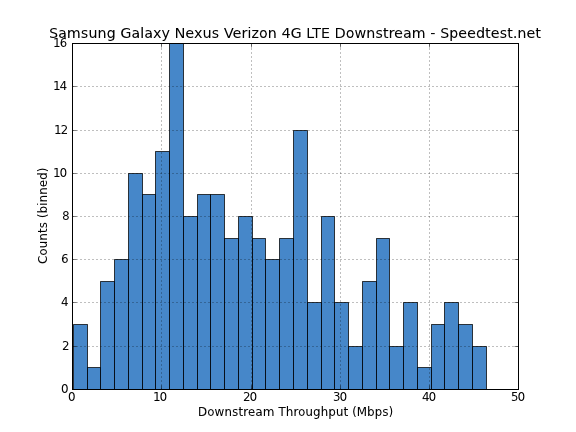
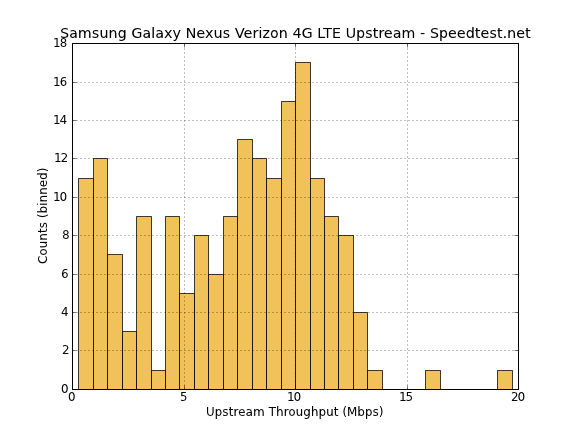
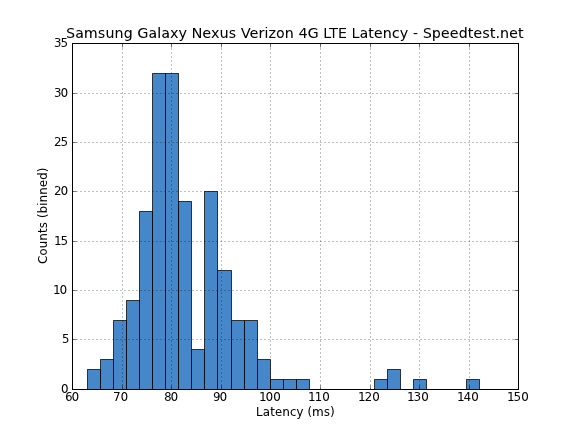
The issue that most people talk about centers around signal strength, and this is where a few misconceptions kick in. I’ve gotten a few emails and tweets and read pages on forums where people are implicitly comparing CDMA2000 1x/EVDO field strength to LTE field strength. The issue here is that on basically all of the LTE/CDMA Verizon handsets, the field under “Signal Strength” in about refers to EVDO signal strength, and not LTE signal strength. The two aren’t comparable at all for a host of reasons - different spectrum (800 MHz and 1900 MHz for 1x/EVDO as opposed to 700 MHz for LTE), and different cells (there’s some correlation, but not every Verizon base station has LTE onboard). The end result is that if you’re comparing 1x/EVDO signal strength to LTE signal strength, you’re making an absolutely meaningless apples to oranges comparison.
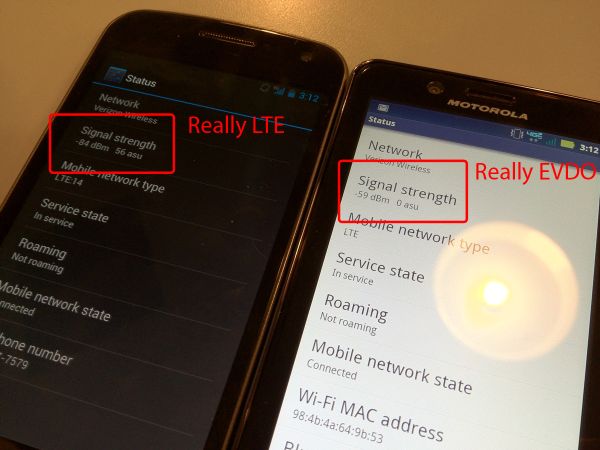
This is not a valid comparison - LTE versus EVDO signal strength
The Galaxy Nexus (and really just Android 4.0) now correctly reports and accommodates LTE by reporting its signal strength under “About->Status” and visualizing that as bars appropriately. Switch to EVDO on the Galaxy Nexus and signal strength appropriately changes to reflect an entirely different air interface’s signal strength. It’s nice to see people using dBm instead of bars when possible (which are effectively meaningless as a comparison metric), but now that there are multiple air interfaces on handsets, we have to be explicit about what numbers we’re actually comparing.
This reporting is a problem I’ve talked about at length in more than one LTE handset review, and to date I only know of ways to show LTE signal strength and channel quality on a few handsets. Samsung’s Droid Charge (courtesy Samsung’s excellent ServiceMode application viewed through *#0011# after some unlock trickery) and the Bionic (through logcat and grepping for the radio signal status daemon) report LTE field strength, but only if you dig for them.
Comparing LTE Signal Strength the Right Way
So how does the LTE Galaxy Nexus compare to the Droid Charge and Bionic, the two handsets we can actually view LTE signal strength in dBm on? Very closely as a matter of fact.
I have a Bionic kicking around which has to go back very soon, but fired up logcat and put the Galaxy Nexus next to it. The Bionic reports signal strength pretty constantly whereas in Android 4.0 the number has some hysteresis, but here the numbers are pretty darn close, with the Bionic hovering between -91 and -95 dBm, and the Galaxy Nexus reporting an average of -92 dBm.
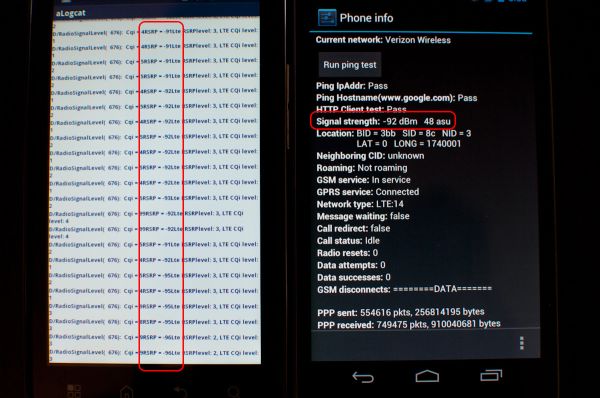
Left: Motorola Droid Bionic (logcat showing LTE signal strength), Right: Galaxy Nexus
Since the Droid Charge is the only other handset I know how to show LTE signal strength on, I tracked a friend down at a local cafe with one and fired up service mode. Again, what’s shown under “About->Status” on the Droid Charge is actually EVDO signal strength. Here the Galaxy Nexus shows -107 dBm and the Droid Charge shows -108 dBm.
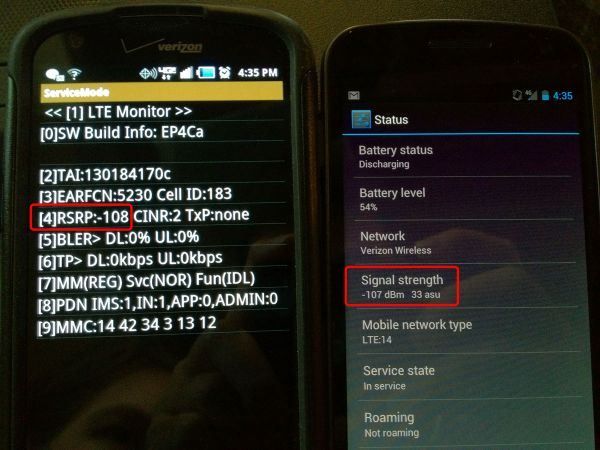
Left: Samsung Droid Charge (ServiceMode) Right: Galaxy Nexus
The Droid Charge is another hilarious example of why you can’t compare bars at all, as the Charge shows a positively laughable 4 out of 5 bars in an area with very low LTE signal strength, whereas the Galaxy Nexus (moreover, Android 4.0) has a very conservative and realistic strength to bars mapping. Carriers love to make things out to be better than they really are, however, and the result is this kind of hilarious visualization which portrays LTE signal as being much better than it really is if you stare at bars all day.
Verizon confirming though a tweet that there’s some sort of signal issue affecting the Galaxy Nexus confuses me, since from my perspective there isn’t any issue at all. The only real issue that exists is that the Galaxy Nexus (and really just the stock Android 4.0 signal strength to bars mapping) doesn’t line up with what Verizon has shipped on other devices, thus leading people to make apples to oranges comparisons and imagine an issue. I wager that some of this confusion is also compounded from the number of Verizon customers that are just now getting their first LTE handset with the Galaxy Nexus. It might be surprising to discover that LTE coverage right now isn't nearly as good as 1x/EVDO, but these things will improve as the carrier's LTE rollout continues. The other big disclamer is that I haven't fully investigated 1x/EVDO performance on the Galaxy Nexus, but this will end up being virtually identical to the Droid Charge.
There’s a CDMA and LTE baseband update coming with the LTE Galaxy Nexus’ 4.0.3 update as shown above, but this will likely do more to address connection stability than change the way anything is reported. Given how much attention this has gotten, however, I would not be surprised to see Google make a change to its signal strength to bars mapping for LTE and placebo away an issue that never really existed to begin with. That's also an unfortunate change, since from my perspective the Galaxy Nexus is one of the first handets that doesn't have an unrealistic mapping. In the meantime, we're still working on our Galaxy Nexus review where we'll take a complete look at the LTE/CDMA and GSM/UMTS Galaxy Nexii.
Update:
As predicted, Verizon has made a statement to The Verge and Computerworld stating that there's nothing wrong with the RF performance characteristics or baseband firmware on the LTE/CDMA Galaxy Nexus. Instead, they will upstream some changes to Android to make the device report its bars visualization in line with the rest of its 4G LTE hardware portfolio.
"[Verizon] will adjust the signal strength indicator to more closely match other Verizon Wireless devices.


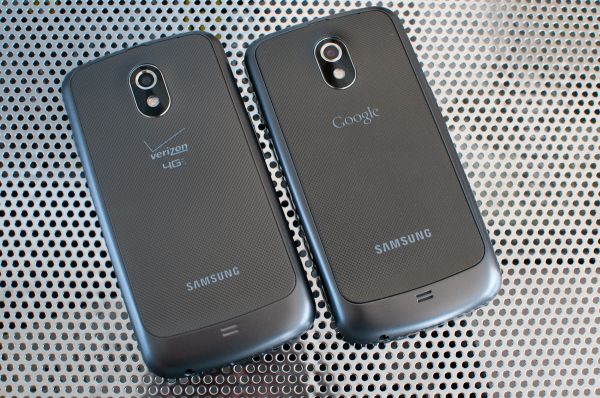









154 Comments
View All Comments
thomase - Tuesday, December 20, 2011 - link
Any battery testing done here MUST also look into standby battery life. Determining how long it takes the drain the battery under constant network load, while important, is not representative of the typical usage pattern. In the real world, phones spend most of the day in our pockets. If there is a real "deep sleep" problem, the message needs to get out and it needs to be loud.Tabs - Tuesday, December 20, 2011 - link
It's pretty apparent there is one from the XDA thread - all kinds of crazy screenshots. My own Android OS is at 23% right now, #2 behind screen - I never saw that process get above single digits on the Droid.TrackSmart - Tuesday, December 20, 2011 - link
I don't doubt your finding, but different versions of android report assess battery usage differently. When my Droid Incredible was upgraded from 2.2 to 2.3 the reported percentages for each process changed dramatically. Similar differences may apply between 2.x and 4.0.So it's possible that the Nexus, in its default configuration, runs more processes in the background (killing battery life). But it's also possible that the operating systems are reporting battery metrics differently.
Just my 2 cents.
thomase - Tuesday, December 20, 2011 - link
Identifying the issue is a lot simpler than looking at the reported battery drain percentages.If you download the BetterBatteryStats app and look at "Other" stats, and see that "Awake" time is significantly higher than "Screen On" time, then there is a problem.
dcdttu - Thursday, December 22, 2011 - link
I've tested my Nexus against two Charges and a Stratosphere while in 3G mode. Definitely is a distant third place as far as signal. This likely explains why I can't keep calls and when I do, the clarity is not very good at all. It's a shame it seems to have such bad 3G/1x reception. It's kind of important...dcdttu - Tuesday, December 20, 2011 - link
I have done this test between my Nexus and a coworker's Charge multiple times and the results are always the same: the Nexus is 10-20dBm less than the Charge with both set to 3G only. That is a huge margin, and not something that should pass through any carrier testing hardware-wise. I think something's wrong with the software of some or all Nexus, reception-wise.ZPrime - Monday, December 19, 2011 - link
I have a Stratosphere and the Nexus, I'm guessing the Stratosphere would be similar to the Charge?Completely subjectively, reception feels worse on the Nexus. Objectively, the "Time without signal" has been FAR higher on the Nexus than the Stratosphere, but I'm not sure how that is actually calculated.
Trying to get into test mode on the strat so I can compare numbers, but I can't find the code after a bunch of googling...
Brian Klug - Monday, December 19, 2011 - link
Correct, the Stratosphere uses the same combination of Via 7.1 + CMC220. If you want to unlock ServiceMode on the Charge (or Fascinate, and possibly the Stratosphere), try the following from: http://androidforums.com/samsung-droid-charge/3713..."Go into the Dialer and enter *#83786633 then press the Home key
Go back into the phone dialer and enter *#22745927
Now a box will come up asking for the SPC code. Enter 000000
Press the Hiddenmenu Enable radio button."
Then you should be able to dial *#0011# (which is the Samsung shortcut for field test inside ServiceMenu) and compare actual LTE RSRP.
-Brian
Steve.P - Tuesday, December 20, 2011 - link
Brian,It is possible to lock the Nexus into a LTE only mode using this service mode? I have the Thunderbolt which I can use the testing mode (*#*#4636#*#*) to enable LTE only. I really find this very helpful in area which I know have LTE but where the phone wants to select 3G instead of LTE.
Steve
mitra88 - Monday, December 19, 2011 - link
Brian,Thanks for a great info about GN. It was very useful to know.
I did a comparison test myself between my new GN and my wife's Thunderbolt. No sure if you are aware, but Thunderbolt users have been using the app called 'LTE On/Off' for switching its network mode. This app also shows the signal strength and other parameters of each network mode. So, I thought that utilizing that app may give me a fair comparison test result.
The result showed the following;
GN in LTE 14: -100dBm
TB in LTE: -80dBm
GN in CDMA - eHRPD: -83dBm
TB in CDMA - eHRPD: -81dBm
Do you think that the test result 2 of TB was actually showing that of CDMA? Not LTE? I checked the About>Status of TB, and it was also -80dBm there. So, I am a little bit confused. Can I trust the number from 'LTE On/Off' app of TB?